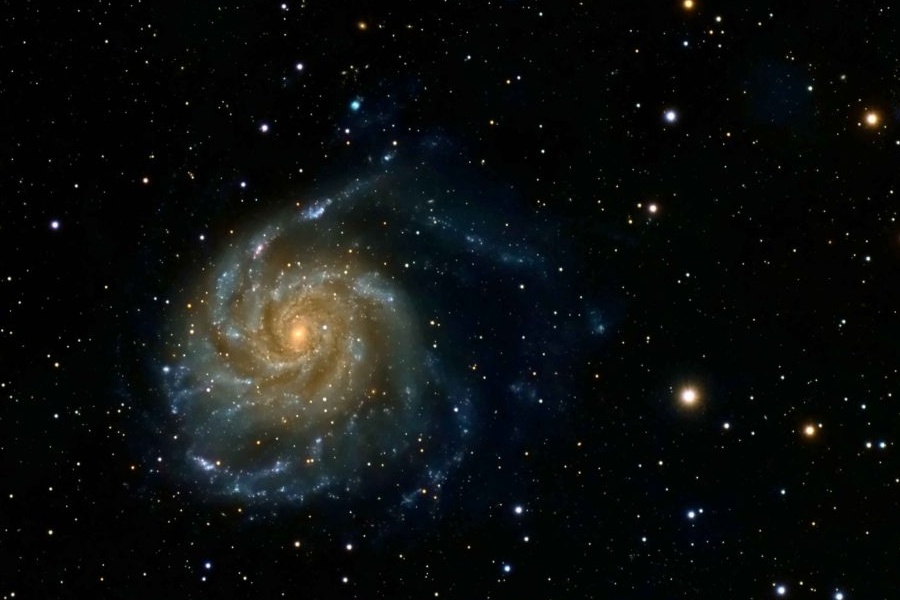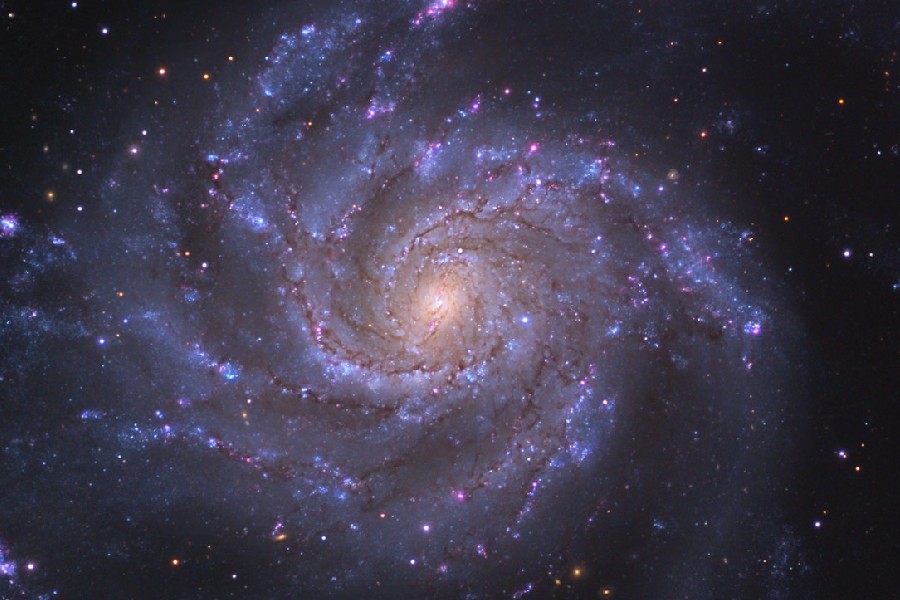In the vast cosmic tapestry, a mesmerizing celestial masterpiece awaits our gaze—the Pinwheel Galaxy. Far beyond our earthly abode, this spiral beauty beckons us to embark on a cosmic journey through space and time.
As one of the most picturesque spiral galaxies visible from Earth, this galaxy has captivated backyard astronomers with its beauty and intrigued scientists. So, we’ll explore what astronomers have learned about the hundreds of billions of stars within it.
Examining the galaxy’s distinct features and quirks will give us insights into how spiral galaxies like our Milky Way form, evolve, and sustain the cosmic dramas seen across its canvas.
Let’s learn!

What Is Pinwheel Galaxy?
The Pinwheel Galaxy, also known as Messier 101, is a stunning spiral galaxy located in the constellation Ursa Major. It is notable for its well-defined spiral arms that give it a pinwheel-like appearance.
The Pinwheel Galaxy size is about 70% larger in diameter than our Milky Way. It is approximately 21 million light-years away from Earth. It is among the brightest and most massive spiral galaxies in the night sky.
Moreover, the Hubble Space Telescope and other powerful observatories have captured breathtaking galaxy images. They revealed intricate details of its structure and contents.
Formation and Evolution
Origins
Unraveling the origins and early history poses an intriguing mystery. One formation theory speculates that an ancient galactic collision could have disturbed gas clouds. This triggered the initial gravitational collapse that birthed the fledgling Pinwheel system.
Over hundreds of millions of years, ongoing gas accretion may have enabled the proto-Pinwheel to bulk up in mass and compactness. This process led it toward eventually blossoming into the stunning spiral evident today.
Lifecycle
Like all galaxies, this galaxy follows a lengthy developmental arc spanning billions of years since first coalescing from the mix of matter filling the universe. In its earliest phases, the Pinwheel was a turbulent swirl of embryonic stars and gas before settling into more organized rotating structures.
Over successive generations, waves of new star formation propagated through its arms. The Pinwheel gradually cultivated its resplendent, well-defined spiral form visible today.
However, potential encounters with the Andromeda or Triangulum Galaxies billions of years in the future may radically alter the Pinwheel. This exposure could subject its stars and gas to dramatic gravitational tides or mergers, ushering in new galactic arrangements.
Location and Characteristics
Galactic address
The Pinwheel Galaxy location graces the night sky within Ursa Major’s constellation. Its celestial coordinates become a beacon for stargazers and astronomers, positioned approximately 21 million light-years away. It invites us to gaze beyond our terrestrial confines.
Physical properties
Spanning a colossal 170,000 light-years in diameter, it stands as one of the largest spiral galaxies in our cosmic neighborhood. Its grand size is a testament to the vastness of the universe. It captivates our imagination with the sheer scale of this cosmic creation.
Within its spiral arms, the Pinwheel Galaxy unveils a celestial masterpiece. Bright star clusters, nebulous formations, and intricate dust lanes paint a cosmic canvas.
These notable features adorn its structure and provide insights into the dynamic processes shaping galaxies. They offer a window into the cosmic drama unfolding beyond our world.

Scientific Significance of Pinwheel Galaxy
Contribution to cosmology
Delving into the Pinwheel Galaxy planets provides astronomers valuable insights into the broader cosmos. By studying its structure, dynamics, and composition, scientists unlock clues about the fundamental principles governing the birth and evolution of galaxies. This contributes to our understanding of the vast cosmic tapestry.
Role in galactic ecology
The galaxy engages in cosmic conversations with its neighbors, influencing and being affected by nearby galaxies.
Similar to celestial dances, these interactions shape the galaxy’s journey through space and time. This offers a glimpse into the interconnected web of galactic relationships. Within its sprawling arms, the Pinwheel Galaxy hosts a diverse population of stars, forming vibrant stellar communities.
The study of these stellar populations unravels the galaxy’s unique story. It enriches our comprehension of the broader galactic ecosystem, highlighting the intricate interplay between stars and the environments that nurture their celestial brilliance.
Observing the Pinwheel Galaxy
Best times for observation
Optimal viewing occurs during spring and summer to witness the Pinwheel Galaxy’s celestial beauty. Ursa Major, the constellation housing this cosmic wonder, graces the night sky during that time. So, you should choose clear, moonless nights for an unobstructed view.
Tools and techniques
Entry-level telescopes, like a 6-inch reflector, offer excellent views of the Pinwheel Galaxy. Binoculars with a wide field of view also provide a captivating experience for stargazers.
Hence, you can delve into astrophotography by capturing long-exposure images. Also, you can utilize DSLR cameras and attachable smartphone adapters for telescopes to immortalize the intricate details of the Pinwheel Galaxy’s spiral arms.
Keep in mind to incorporate tracking mounts to enhance image clarity during prolonged exposures. This ensures a stunning visual record of your cosmic exploration.
Exploration Missions
Past and ongoing
Over the years, esteemed space telescopes such as the Hubble Space Telescope and the Spitzer Space Telescope have diligently turned their lenses toward the Pinwheel Galaxy. These missions have provided us with mesmerizing images and crucial data, deepening our understanding of this distant cosmic spectacle.
The intrigue continues with upcoming missions poised to unveil fresh perspectives on the Pinwheel Galaxy. The James Webb Space Telescope also stands as a beacon of anticipation. It will further delve into the mysteries of this celestial wonder, opening new frontiers in our exploration of the cosmos.
Fun Facts and Trivia
- The Messier 101 is in constant motion despite its serene appearance. It completes a full rotation approximately every 200 million years, orchestrating a cosmic dance that spans epochs.
- While its formal name is Messier 101, the galaxy earned its popular moniker, the Pinwheel Galaxy, due to its striking spiral structure resembling a celestial pinwheel in the vast night sky.
- Despite its enormous size, the Messier 101 is one of the faintest galaxies visible to the naked eye, requiring optimal viewing conditions away from city lights for the best celestial spectacle.
- It is estimated to contain over 100 billion stars, easily rivaling the Milky Way.
- Despite its size, the Pinwheel lurks near the limits of human vision. Its dim magnitude of 7.9 means pristine viewing conditions are vital for spotting this gossamer galaxy with the naked eye.
Frequently Asked Questions
Why is the Pinwheel Galaxy so photogenic?
It is photogenic because its face-on orientation, as seen from Earth, makes its spiral arms look like an elegant, cosmic pinwheel.
The arms are also well-defined and exhibit areas of intense star formation that glow brightly against the darker arms. This creates beautiful contrasts and striking details when photographed.
Does the Pinwheel Galaxy have a black hole at its center?
Astronomers believe there is likely a supermassive black hole at the Pinwheel Galaxy’s core, weighing in at over 1 million solar masses. Material pulled into this black hole likely powers radiation and emissions from the galaxy’s very active and bright core region.
How do we study and observe the Pinwheel Galaxy?
It is visible with backyard telescopes, especially on clear and dark nights. But astronomers rely on advanced telescopes like the Hubble Space Telescope and large observatories on Earth to study it in greater detail. These tools allow us to see features like star clusters, nebulae, and star-forming regions across the galaxy in multiple wavelengths.
Conclusion
The celestial Pinwheel will continue turning gracefully amidst the deepening black for millions of years. Its once vibrant arms will fade and be continuously renewed by light from stars not yet born.
Though the mysteries surrounding its many stars may never be fully unlocked, the images that powerful telescopes capture will provide endless inspiration. Within its beautiful glowing mist resides all the dynamics and complexities that crafted our home in this universe – the Milky Way.
We leave the Pinwheel Galaxy as yet another story about science and art wrapped around a galaxy pinwheel comes to an end. We are even more awed by the eternal dance between light and matter that illuminates the theater around all galaxies.
